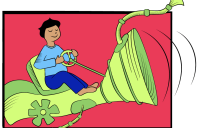This month, Harvard took a bold stand, declaring the USDA‘s food guide icons inadequate and out-of-date:
For nearly two decades, the U.S. government distilled its nutrition advice into pyramids. These efforts didn’t accurately show people what makes up a healthy diet. Why? Their recommendations were based on out-of-date science and influenced by people with business interests in the messages the icons sent. This year, the U.S. government scrapped its MyPyramid icon in favor of the fruit-and-vegetable rich MyPlate—an improvement, yet one that still doesn’t go far enough to show people how to make the healthiest choices.
Researchers in the Department of Nutrition at the Harvard School of Public Health, in conjunction with Harvard Health Publications, are now offering alternative icons to MyPyramid and MyPlate.

Harvard’s Healthy Eating Plate adds emphasis on healthy fats and water, mentioning that diary should be limited to 1-2 servings per day. Physical activity is also a part of each of Harvard’s graphics. Read a comprehensive comparison of the icons here.
While the Healthy Eating Plate addresses some of the shortcomings of the USDA’s MyPlate, it’s been criticized as being to “nutritionally annoying“. Harvard’s Healthy Eating Plate may be too text heavy for some, and unrealistic for others, putting in place barriers to behavior change.
Neither are perfect. Nutrition is complex. Without greater education and support from nutrition professionals in our schools, health care system, and communities, simple guides to healthy eating alone won’t cut it in our struggle to realize a healthier nation.




Fascinating…now’s when the USDA should run a contest and have graphic designers blend the two – Harvard + USDA original to find the winning formula.
Agreed, open it open for collaboration and see if we can come up with a kick-ass infographic!
I love infographics as much as the next guy (gals, too), and I’m skeptical that one will work for the concept of healthy eating as a whole. What do you think? How might they be improved further?
Well, since you asked, 🙂
I’d keep the plate in the center as the focal point, but provide other info around it such as – differences in diet intake between men and women, guidelines for serving sizes, a two column chart with dos/don’ts or myths/facts.
I think the Harvard one may have been more concise on purpose. Health is a complex topic but it is also very important to convey, and people need to educated on it. I think there is room to add some more info without making it too confusing.
While the Harvard Healthy Eating Plate certainly provides more information and is a fairly strong infographic, the MyPlate seems to be more in-tune with what the average consumer can remember with a quick glance. As someone who strives to be an informed consumer, the Harvard graphic is more up my alley. For my children who are not there yet, the MyPlate graphic will be more up their alley. I agree with Andrew’s comment below – can they be merged?